Your search for * in botany has returned 100 entries
incatyatou
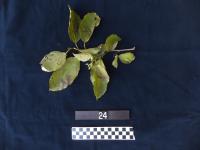
n. tree. Acting as a fence post. (collection: Ashley A McGuigan #24)
Example: 1. For vomiting/uneasyness - remove the bark of a stem and take the inner bark (this should be white). Smash the white bark with about 150ml of cold water and drink. The bark can also be boiled and cooled down to drink cold. Believes when you vomit a lot this will restore your body and give you energy again. Take after vomiting but can use even when not sick. 2. For stomache ache - Can also be prepare and taken as in part 1. 3. For painful urination, also prepared as in part 1. 4. The fruits are sticky and used as a type of local “glue.” Collect the fruits when ripe, hold the outside of the fruit in the hand, and put the end of the fruit that has the sticky sap on paper or anything else needing to be glued. In ancient times, this sticky glue helped join the strings together that were used to make a long fishing line. 5. In ancient times this sticky glue helped join the strings together when making a long one for fishing. 6. During the heat of the day, in the hot season, take inner bark from 1 stick, scrape bark into 1 liter water and drink all day to help prevent a person from getting urinary infection, resulting in painful urination from being in the sun too much. 7. If you put the leaves of this plant in a bag with your fishing gear – it will help catch a lot of fish – magic. 8. Cut a 1-2 m long branch in each of 4 corners of the garden which is a rectangle, place it in an “X” at each corner, this will cleanse people who have not been cleansed who come in the garden. 9. If a person is not cleansed e.g. has not fasted from certain foods, the crops will not bear good fruits. So when gardening, people believe it is best not to eat coconut, shellfish, fish, stay away from sex, and no fermented food like breadfruit and bananas, OR if you have a visitor overnight and then you heal to cleanse yourself before going to the garden. After a woman finishes her period, she will stay out of garden for 10 days, this is specifically for kava, water taro, sugarcane and yam in the garden. Other crops – cassava, sweet potato, and taro Fiji are okay. Different Kastom for N, S, W, E people – so this Kastom is for South and Eastern people.
bookmarkinceihuri

incejev ataheñ

incipiñti

inciñpiñti

incowos

n. herb to 1. 5 m, flowers white with pink tips. Growing on sandy path along coastal walk to ute. (collection: Michael J. Balick #4989)
Example: The leaves of this plant are used to finish the ridge of the house roof. Lay the leaves horzontally on top of the roof, and the sides of the roof are thatched with palms or grass. Layer 10 leaves on top of each other to enable this part of the roof (known as nitjintiniom) to last for a long time--perhaps up to 6 years. If this is used on the top of a roof where there is a fire burning, such as a kitchen, and this leaf gets a lot of smoke, it can last much longer a the top of the roof--perhaps 10 years or more.
bookmarkinhoam̃a

n. shrub, 1 m tall (collection: Gregory M. Plunkett #3441)
Example: Flowers put in hear as an ornament that has power because it is so beautiful. Leaves are burned and added to a bamboo pipe and mix with a foam that forms in fresh water, when people go to a traditional dance, men paint part of their face eyebrows and beard to attract attention, hence the name, pone part of which "am̃a" means "staring", because it will cause people to stare at the one wearing it.
bookmarkinmac
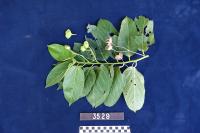
inmowad u pikad
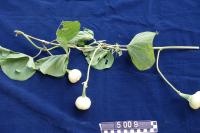
n. vine to 5 m tall in trees, fruits maturing yellow-brown. Growing in agroforest/secondary forest. (collection: Michael J. Balick #5009)
Example: People collect this vine and feed it to pigs. It also has an unspecified medicinal use. The vine of this plant forms a thick canopy so some people plant it around the house near trees that do not give much shade in order to reduce the intensity of the sun on the house and thus keep the temperature lower. The vine grows quickly into the trees.
bookmarkinrokdania
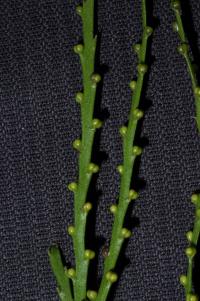
n. epiphyte on trees, growing in dense rainforest. (collection: Gregory M. Plunkett #4093)
Example: 1. Sickness blo namya. When a man accidentally has intercourse with a woman during her menstrual cycle, he can become sick. The leaves are squeezed, along with others, to produce an extraction. The dose and duration varies according to the degree of the symptoms. Further information about the preparation withheld.
bookmarkinrowod
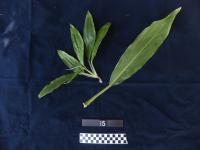
n. shrub. Found along village pathways and in gardens. (collection: Ashley A McGuigan #15)
Example: 2. To cure headaches casued by bad spirit - Take one top from Nelmaha and one from inrowod (white stripe variety) Combine and chew these then spit them out and apply to the sick persons forehead.
bookmarkintel e cha

n. terrestrial orchid, growing in open (collection: Gregory M. Plunkett #3523)
Example: This is a "message plant." If a person puts the flower behind their ear and then stares out at you, or tosses the flower to you, then say yes and follow them, for example, to drink kava, or to go swimming. Or a man invites a woman to go somewhere with him. Alternatively, you can leave the flower on a table and this is also a message to go with a person. Leaves also used to wrap foods. Decorate yard around the house.
bookmarkintesyanam̃a
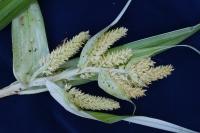
intijgancedo

n. prostrate herb growing on ground in open or partly shaded area next to banana tree. (collection: Gregory M. Plunkett #3207)
Example: 1. The plant is named after a "rat"s ear.’ Eat 4 fresh leaves every morning to clear the brain and help remember things. 2. This plant is an indicator of rich soil--a good place for growing vegetables. 3. Very useful plant, food and medicine. Name means rat ear. Take 5 leaves, wrap in INROWOD (Cordyline fruticosa) and cook for 15 minutes, remove it hot (be sure you do not burn it) squeeze out 1 tablespoon and give to baby to drink to treat a flu. 1x morning for 5 days.
bookmarkintoho

n. tree, 10-12 m tall (collection: Gregory M. Plunkett #3638)
Example: This tree is a good source of firewood, wood for house posts as well as sawn timber. The ripe fruit is edible but some of these are sour. Kids eat fruits – it is black. Pick only the most ripe fruits. This species grows commonly on river banks.
bookmarkintopasyejitohou

n. herb to 50 cm tall, flowers yellow. (collection: Michael J. Balick #4947)
Example: To treat toothache, collect the uppermost young leaves, rub them in your hand, put mass of crushed leaves into the area of toothache to lessen the pain. Do this as needed until the pain goes away. Keep it in your mouth for 10 minutes then spit out, then add a new one, keep going as needed.
bookmarkintop̃ asiej

inwae

n. tree, 3-4 m tall (collection: Gregory M. Plunkett #3563)
Example: Children like to eat the fruit of this plant. It is said to taste like pineapple/mango. It must be very ripe to be eaten. Peel and discard the skin. The fruit is most sweet when it is on the ground for a few days. Some children eat the seeds of this fruit but it has a strong oily taste--too many cause vomiting and if a person eats 1-2 seeds it can cause diarrhea.
bookmarkinwoapeñ

inwoudec

n. liana climbing on large Dillenia tree, growing in primary forest at edge of river. flower white. (collection: Gregory M. Plunkett #3677)
Example: If a person is building a temporary house and has no other way of attaching the poles, collect the vine of this species, roll it a bit to break the fiber, heat it in a figure 8 form and then use for tying poles while warm.
bookmarkinwowityuwun

n. parasitic vine scrambling over Scaevola taccada, at edge of strand. Fruits green. (collection: Gregory M. Plunkett #3545)
Example: 1. Take a handful of vine, pound it and wash hair, like shampoo – makes hair curly and like rasta. 2a. This is a "message plant." If a person is walking through a village that is not his, people know that they come in peace. 2b. Message plant - if a group is discussing something and one person goes out and makes a head les of this vine, it means that there can’t be an agreement. 2.) If you are angry at a person, drop the vine at their door, in the case of a visitor or land dispute and they need to leave.
bookmarkinya

n. large tree, 16 m tall (collection: Gregory M. Plunkett #3222)
Example: 1. As a child’s game, some times children put the segments of the needles together to see who can make the largest one. 2. A "calendar plant"--when the needles are brown, it is an indication that people should not work hard, but should rest or they will not feel well. If they try to work they will feel sleepy--an indication of the season of higher heat. 3. Wood is used as firewood. 4. Firewood, inner bark good for ciguatera poisoning, scratch the inner bark and squeeze juice into a cup of water and give to the sick person to drink – very effective. Use the largest most mature part of the stem.
bookmarkinyiivac
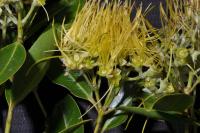
korari

n. herb growing to 2 m tall, flower white (collection: Michael J. Balick #4974)
Example: Put the leaf in seawater for two months, this will rett t he fibers. Then collect the fibrous strings and dry them in the sun, and use them for weaving. In the past this plant fiber was used to make rope but not at present.
bookmarkmaputu-ligighap
n. the stem of a coconut leaf used for a butt
bookmarknafanu

n. tree, 6 m tall (collection: Gregory M. Plunkett #3530)
Example: This plant grows in coastal areas, and is a good source of firewood. It can be used for house posts. The leaves are used as an unspecified medicine. There is a belief regarding the black and white sea snake, that represents a seawater spirit. Mix this with other unspecified leaves, mash together, squeeze into a bamboo tube and fill it. Give it to a woman to drink to keep the evil snake spirit away. The same preparation can be used to treat toothache, caused by the seawater spirit. "The spirit can trick you into going to fish every day."
bookmarknagatia

n. treelet 2. 0-2. 5 m tall, dbh 3 cm (collection: Michael J. Balick #4858)
Example: If a chief passes away, they are burred in a sacred place. After burial, the people wash their hands with these leaves, mixed with water. The chiefs have a spiritual power and this is used to cleanse the people attending the funeral so that they do not get large sores on their leg or elsewhere on their body. This is part of the ritual for burying the chief.
bookmarknakhe

n. fern. Growing in a village back path. (collection: Ashley A McGuigan #29)
Example: 1. To cure when the anus falls out - Pound together 1 braches worth of inpalcapnesgin leaves and of both inloptiri (2-4 leaves, any age), also take the inner bark of nekeaitimi and nakhe. Put this into your hand, or another leaf and give it to the person to use it. This should be applied to the anus whenever the anus comes out. USed to use a clam shell to extract the bark but not anymore.
bookmarknala

n. shrub to 2 m, coastal vegetation (collection: Michael J. Balick #4961)
Example: The stem of this plant is used for firewood. If a person has been drinking kava and the next morning feels hung over, they can take a handful of the leaves of this plant, crush them in cool water, and wash their face with this. This treatment will help the kava feeling to disappear.
bookmarknametreyeñ
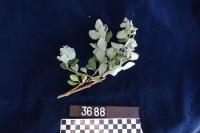
namlau
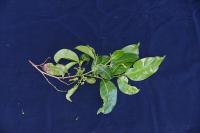
n. shrub, 2 m tall (collection: Gregory M. Plunkett #3490)
Example: 1. The larger stems of this plant can be used to build houses, for rafters. 2. It is also a good source of firewood. 3. Ancestors, before go to chief’s canal and want to talk about a complicated issue – a person would cut a branch and bring it to the sea and tap the water surface and would say what he wants, ask that he would want that issue to be solved and that others would follow his ideas and then go back to the meeting place and take stick, keep wind at his back, moving stick in all directions and then he will convince the people of his ideas. This is done by the chief’s spokesman. Helps convince the opposition. Helps keep power in hands of parent(??) chief rather than subchiefs who might have other ideas.
bookmarknanad

n. shrub, 1 m tall (collection: Gregory M. Plunkett #3553)
Example: 1. A stimulant plant. If a person is going to their garden early in the morning before the sun come up, break 2 top young leaves and chew and swallow the liquid, spitting out the fiber. This makes the person able to work harder and not feel tired while in the fields. It was noted that "a person can do the work of many people if they chew this." 2. The leaves are used for fertilizer for taro--put a bunch of leaves in a hole were taro is to be planted as a compost/antibiotic. This practice is said to kill all of the bad organisms such as bacttively impact the health of the taro plant. 3. This one collected from coastal area, ?? one collected in forest area. People take 4 leaves, chew leaves, swallow juice, gives energy to work hard the entire day. For fishing, take lots of ripe fruits and put in pocket, you will be able to catch a lot of fish. It brings good fortune when fishing. Roots – take one root, wash where a woman is giving birth to a newborn baby, give a drop of the juice from the root to clear the mucus in the throat.
bookmarknanad itohou
![1. The leaves of this plant are used as a fertilizer when a person plants taro "to help to feed the ground for next year." 2. Sapwood of this tree, and one more [GMP 3591], in old days take from west side and cross mountain to the east, and on red clay mountain, burn it to make spirits to give more sun instead of rain so that gardens will grow well.](/media/aneityum/pix/GMP_3456_MJB_43-scaled.jpg)
n. shrub, 2 m tall (collection: Gregory M. Plunkett #3456)
Example: 1. The leaves of this plant are used as a fertilizer when a person plants taro "to help to feed the ground for next year." 2. Sapwood of this tree, and one more [GMP 3591], in old days take from west side and cross mountain to the east, and on red clay mountain, burn it to make spirits to give more sun instead of rain so that gardens will grow well.
bookmarknanini

napaecei

naparap

n. epiphytic fern on main tree trunk, growing in dry forest. (collection: Gregory M. Plunkett #3504)
Example: This is a medicine to treat fresh cuts. Take the leaf of this species, macerate it and add 1 tablespoon of water and wrap in a Macaranga leaf, and then heat it on a fire. After heating, puncture the side of the Macaranga leaf and drop the hot juice on the fresh cut. This is said to be good before going to see the Dispensary or if you do not have access to a health care professional.
bookmarknapojev

n. sparsely branched tree, growing in open (collection: Gregory M. Plunkett #3477)
Example: The leaves of this plant are used in cooking, particuarly with the earth oven. Use a fire to heat stones, then when the fire burns down and the stones are hot, pile these leaves on top of the hot stones and then place the food being cooked--taro, fish, pig, cassava, banana or other foods--on top of the leaves. Then pile more of these leaves on top of the food and then place additional hot stones on top of that pile of leaves. While the food is cooking--each type of food takes a different amount of time--the leaves give off a very nice smell and help flavor the food.
bookmarknarijo

nasjiramnem

n. grass to 20-30 cm tall, florets brown. Growing along trail. (collection: Michael J. Balick #4970)
Example: This plant is used to make a medicine to stop bleeding, as a styptic. Squeeze a handful of leaves together and apply the leaves as a poultice to the wound or drip the juice on the wound when it does not seem wise to put pressure on the bleeding. This will stop the blood from flowing from the wound and is only to be used on a small wound.
bookmarknauhap̃

n. small tree or shrub, 2 m tall (collection: Gregory M. Plunkett #3210)
Example: 1. Use the leaves to put in a hole where taro is being planted, as a sort of fertilizer--it rots easily and adds value to the soil. To protect a person from spirits if you are going to an unfamiliar place, take the young inflorescence and put behind your ear. This plant is a sort of "spiritual kava." 2. Flowers are put behind one ear, any side, to allow a person to pass through sacred places. For protection of the spirits especially if you are familiar with this place. On EAST SIDE, put one leaf under pillow before sleeping so that the lady spirit will not disturb the person. Only for men – spirit likes men, and wants to have sleep with them. If she gets pregnant, you must follow her to look after the kids in the spirit world so you leave this one (you die). 3. The small, straight stems of this plant are used as rafters to weave thatch. 4. Children make bows and arrows from the stems as well as spears for fishing.
bookmarknauun
n. a stem
bookmarknecjopdak

n. scrambling vine, growing in coastal strand vegetation. Flowers yellow. 1. Medicine: Smash leaves 1 handful, into cup and add a small amount of water to treat constipation—1 cup for children; 1.5 XX for adults. 2. Stomachache: same treatment, will clear bowel. 3. For leg sores, collect whole plant, put in water – a pool of water for 1 week, then use to dip sore as on leg into it for 10-15 minutes cure the sore. (collection: Gregory M. Plunkett #3437)
bookmarknecjop̃dak

n. low-growing, creeping vine growing in grassy area just inland from coastal strand. Flowers yellow. (collection: Gregory M. Plunkett #3223)
Example: The leaves of this plant are used to treat stomach ache. Take a handful of leaves and mix with 1/2 liter of water, crush the leaves in the water and drink the entire amount when your stomach hurts. Alternatively, this can also be consumed 1x a week as a tonic drink for the stomach and system.
bookmarknecjop̃dak

n. prostrate creeping vine along coastlines. (collection: Ashley A McGuigan #10)
Example: 1. To cure rubbush blood - Take a handfull f leaves of any age, pound it into a cupfull of water, squeeze the juice and drink when woman feels pain in head or inside the body or when the inside of the body is hot. Drink this once a day until the pain goes away. 2. To cure excessive bleeding after giving birth - boil naojapdak leaves (2-16) in seawater until leaves are soft and the water is brown. Sit on this water. 3. To close the cervix - boil 2 naojapdak leaves in water and bath in it. 4. Medicine: Smash leaves 1 handful, into cup and add a small amount of water to treat constipation—1 cup for children; 1.5 litres for adults. 5. Stomachache: same treatment, will clear bowel. 6. For leg sores, collect whole plant, put in water – a pool of water for 1 week, then use to dip sore as on leg into it for 10-15 minutes cure the sore.
bookmarknecñanjaa

n. shrub to 2 m, dbh 3 cm (collection: Michael J. Balick #4862)
Example: The common name of this plant refers to the footprint of a chicken. Mix the dried leaves of this plant with pieces of coconut and feed to chickens. They are said to really like it. Plant the shrub near the place that chickens are kept. This feed will make the chickens produce more eggs and also increase the number of healthy chickens.
bookmarknecñopod

nednaeñ
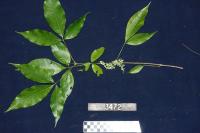
nednaiñ lelcei

nedwodou

n. tree, 10 m tall (collection: Gregory M. Plunkett #3531)
Example: 1. For a child around 1 year of age, take the inside bark, mash it, boil in hot warter and then use it to wash the child. This will ensure that the child will grow strong and make them able to crawl fast. 2. If a woman who is one month pregnant would like to have a baby, she is given 4 of the tips of the branches to chew and swallow everything before breakfast 1x only. 3. For fishing, take 4 leaves, hold top side up, tear right half of leaves off, keep left side, roll it up and put with fishing gear to have good luck when fishing in the deep sea beyond the reef.
bookmarknejecjec

n. epiphyte c. 1 m above forest floor, growing in secondary forest above river. (collection: Gregory M. Plunkett #3650)
Example: The younger,soft leaves are used to wrap local foods, for example bananas. To prepare a type of "local cheese," made from fermented breadfruit and fermented banana, mix a bit of coconut milk and wrap these two fruits in the leaves and cook under ground. Not clear about the way the food is fermented.
bookmarknekeiatimi

n. terrestrial fern, growing on rocky area in secondary forest above the river. Leaves c. 3 m long. (collection: Gregory M. Plunkett #3654)
Example: The leaf is wrapped around the head as an adornment by both men and women. If a person gets burned by a fire, scrape the petiole of this plant and squeeze juice on the wound to cool and heal it. Use as long as needed. The ancestors are said to have cooked the stump of this plant in an earth oven, over 2-3 nights, and then ate it. It is said to have no taste but was more of a famine food during periods of drought.
bookmarknekro
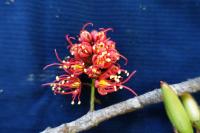
nekro

nelm̃ae

n. small tree. Found in the village, but not cultivated. (collection: Ashley A McGuigan #17)
Example: 1. Ancestors used this plant to make fish line – cut young branches, remove outer bark and tie together, put in salt water or fresh water for a week, it is now strong, dry in sun, take fibers and twist them together to make a very long fishing line. 2. Leaves are used to feed pigs. 3. Take inner bark, scrape it and put on boils. Attach with any leaf and it takes out the boil. 4. Trunk for temporary bush house.
bookmarknemla

n. tree, 4 m tall (collection: Gregory M. Plunkett #4127)
Example: 1. This wood can be used to start a fire, where there are no matches. Two dried pieces of wood are rubbed vigorously together to create tinder. The tinder is then added to dried material in order to start a fire. 2. The wood of this plant is used as rafters in traditional houses.
bookmarknepelvanwou

n. liana, on Polyscias cissodendron (collection: Gregory M. Plunkett #3457)
Example: 1. Macerate the young stems, remove the outer "skin" to release the odor of the stem and weave into a head garland for decoration. 2. People use it as a headdress. This is a male plant, ancestors used both male and female wrapped together for the headdress. Man would put this on head to attract a woman that he liked. Be careful when you are passing other women who will be attracted to the wearer – so the person can’t speak to them so he can focus on the one he is attracted to.
bookmarknepilvan
n. tender shoots
bookmarknepya

n. tree, 6 m tall (collection: Gregory M. Plunkett #3541)
Example: 1. The young leaves are placed under a pig being cooked in the earth oven, on top of stones, the fat drips on the leaves and then people eat the leaves with pig fat on it--said to be delicious. The branches are used to make pig pen fences. 2. Collect top branches, chop leaves boil and eat like island cabbage – or cook on charcoal and wrap fish w/ this leaf.
bookmarkneroa

nese
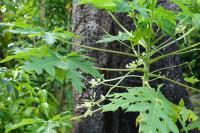
n. shrub to 2 m, flowers white. forest near house. (collection: Michael J. Balick #4871)
Example: A handful of flower buds are collected and put into water with 1-2 pieces of papaya roots. Heat the water and drink it hot for the treatment of hypertension or vein problems, or to promote circulation in overweight people. Do this treatment 1x a month. The white sap is collected and used to soften octopus flesh for eating. Put sap, fruits and chopped leaves in a bowl and add the octopus, allowing it to remain in the bowl for 1 hour--this will soften the flesh of the animal. The sap can be used to wash the skin of tough beef or wild pig--it helps to "burn" off (remove) the skin. When cooking tough meat, take young fruits of this tree and cut them up and put them in the pot with the meat, boil it to soften the meat which can then be cooked.
bookmarknetemu or nidwumnumu

netethei

n. shrub. Uncultivated around the village disturbed areas. . (collection: Ashley A McGuigan #27)
Example: The fruits are edible when ripe--eating them turns the tongue purple. 1. To cure headaches - Someone other than the woman must prepare this. Break the top branch of netethae and remove leaves for use. Combine with the top leaves of the top branch of nelmaha. Chew the leaves and drink the juice. Do this when the sun is setting on the horizon. The woman gives the leftover fibers to the person who prepared the medicine and that person goes and throws the fibers in the direction of the setting sun. 2. Ancestors 4 top branches and chew and spit out remaining fiber will destroy the effects of a love potion that is too strong – meaning that the husband or wife will miss the other person too much so that they become mentally ill. 3. Edible fruits: eating them turns tongue black/purple.
bookmarknethopdecraeñ

netigi

niditau

n. tree, 3 m tall (collection: Gregory M. Plunkett #3507)
Example: The young leaves and fruits are edible; the fruits are eaten ripe. This species is used for firewood as well as house posts, but they don’t last as long as other types of wood so they are used in temporary structures. A sacred plant on Aneityum. Name means linkage between this world and the spirit world. Agriculture – you find this tree ?? it means that the land is fertile. Birds eat fruits; people burn the tree to release ash and fertilizer and grow their taro around it – it will give more food. Message plant – if someone puts a long brown on your door or in your garden, it means “why are you here?” Implies that you should go back to where you belong. You don’t belong in this place. For example instead of quarreling over land dispute, put the branch and it means that you should leave this place.
bookmarkniditau

n. tree. Found in the village. (collection: Ashley A McGuigan #14)
Example: The young leaves and fruits are edible; the fruits are eaten ripe. This species is used for firewood as well as house posts, but they don’t last as long as other types of wood so they are used in temporary structures. A sacred plant on Aneityum. Name means linkage between this world and the spirit world. Agriculture – you find this tree growing, it means that the land is fertile. Birds eat fruits; people burn the tree to release ash and fertilizer and grow their taro around it – it will give more food. Message plant – if someone puts a long brown on your door or in your garden, it means “why are you here?” Implies that you should go back to where you belong. You don’t belong in this place. For example instead of quarreling over land dispute, put the branch and it means that you should leave this place.
bookmarknijinga

n. shrub to 2 m, flowers blue-purple. Red clay soil (collection: Michael J. Balick #4878)
Example: A stem of this shrub is sharpened and used to dig a hole for planting kava. When a person plants kava in a hole made from this stick, there is the belief that it will make kava root stems strong and large. The fruits are edible when ripe and said to be sweet.
bookmarknijomkan

n. shrub to 1 m, dby 2 cm (collection: Michael J. Balick #4999)
Example: It is said that if you chew these leaves or boil them in water and drink the tea from these leaves it will spoil your teeth. There is assumed to be something bad for the teeth in this plant. Local name "Nijom" =tooth and "Kan" = break.
bookmarknikam
![1a. This plant is a "message plant." If a person goes to another village with a leaf of this species in their hand, then people know that someone is coming, and this is reflected in the local name. 1b. Message plant – if you pop by someone’s house and drop leaves there, people know someone has visited them. You can ask neighbors who came by. 2. The fruit is a source of a nut that children love to eat raw. 3. It is known in Bislama as "false mango" [kiyaman mango].](/media/aneityum/pix/GMP_3481_MJB_97-scaled.jpg)
n. tree, 8-10 m tall (collection: Gregory M. Plunkett #3481)
Example: 1a. This plant is a "message plant." If a person goes to another village with a leaf of this species in their hand, then people know that someone is coming, and this is reflected in the local name. 1b. Message plant – if you pop by someone’s house and drop leaves there, people know someone has visited them. You can ask neighbors who came by. 2. The fruit is a source of a nut that children love to eat raw. 3. It is known in Bislama as "false mango" [kiyaman mango].
bookmarknilec

nilpudou
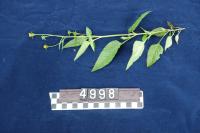
n. herb to 70 cm, florets yellow (collection: Michael J. Balick #4998)
Example: To treat a headache, especially from the flu, boil a handful of leaves in 1 liter of water for a few minutes, let cool and drink 1 cup of liquid per day . Also can treat this type of headache by using the plant in a steam bath, by boiling 4 handfuls of leaves in a pot of water, covering the head with a towel and breathing in the steam from the pot.
bookmarknisjin
n. shoots of plants of bananas
bookmarknohun
n. stem
bookmarknomodej wow
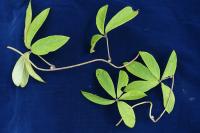
n. vine to 2 m, aerial tubers and lobed leaves. (collection: Michael J. Balick #4946)
Example: This is a root crop. It is harvested in April-June. The leaves turn yellow and indicate that the crop is ready to harvest. If planted in the old days the root would get much larger. It is a good cyclone disaster food. Grows wild now. Boil the tuber in fresh water, when it is cooked add a bit of sea water to give it a salty taste. Chew the starchy root and spit out the fiber. Another variety is like sweet potato and a person can eat the entire root without spitting out the fiber. Can mix with coconut milk as well to eat.
bookmarknop̃oi

n. sprawling, vine-like herb (collection: Gregory M. Plunkett #3215)
Example: 1. The flower of this plant is used for decoration, for Christmas in particular, in church and home. 2. To attract a mate, put the flower in your hair. 3. This is the introduced one that is named after the wild type.
bookmarknourasjohou

nowyeyang
n. shrub to 2 m tall, flowers pink (collection: Michael J. Balick #4955)
Example: The tubers of this variety are sweet, not bitter and are eaten after cooking. The young leaves are eaten after boiling in water until they are soft, either plain or cooked in soup. It is important to only harvest and prepare the young leaves in this way, as the older leaves will not get soft even after cooking. The young leaves are used to cover the top layer of the earth oven, on top of the stones that comprise the upper layer of the earth oven.
bookmarknuae

n. vine, growing in open disturbed area. flowers white. (collection: Gregory M. Plunkett #3589)
Example: To build a cyclone house, take the vine of this species to tie pieces of the house. To prepare the vine for use as rope, collect many feet of it, put it in a fire, roll it in a figure 8, wait until it softens and then use for tying. This vine is hard and
bookmarknuei

n. vine climbing up a dead tree, growing in dense rainforest. Fruits green. (collection: Gregory M. Plunkett #4056)
Example: 1. The stems are used as a traditional rope to fasten house posts. First a length of stem is coiled in a figure-eight pattern. It is then heated to render it pliable. Once heated, for several minutes, it is immediately used to fasten the posts. When cool, it is set and inflexible. Such a fastener can last 20 years.
bookmarknumu yehec

numurumu

n. epiphyte on Syzygium tree, growing in secondary forest along trail above river. old fruits. (collection: Gregory M. Plunkett #3660)
Example: Put several leaves of this species together to wrap food, especially the fresh water eel, and to carry plants of taro, kava, holding the leaves over one’s shoulder to carry these crops. Used as a baby’s remedy for when the baby is crying too much because the parents are having to much sex. The baby will also be slow to grow and be thin. To remedy this, must wash the baby with the following mixture: nekei atimi (bark), nohos atimi (green skin of the stem), nepnatimi ataman (part not specified). Scrap about 1 inch cubed of the nekei atimi into your hand along with 1in x 4in of the first layer of the green skin of the banana stem (nohos atimi), and the top 8 leaves from about two separate branches of the nepnatimi ataman. Bind all ingredients together and pound them and put everything in the baby’s water for bathing. Wash the baby in water made with this mixture. Do not wipe the baby dry but let it air dry. The next day when you wash the baby with soap, you must re-wash them with the mixture again. Do this for 5 days with the same water mixture. It may small bad but that is okay. Finally on day 5, take the juice from the outter layer of skin on the stem of the banana, nohos atimi, and give a full spoonful of the juice to the baby to drink. Other plants can be added to the bathing water but these are the three primary ingredients.
bookmarknup inceen
n. the rib of a leaf
bookmarknupsin
n. seed
bookmarknupsinhodaeñ

nupunyepec

nuput, noho’ich

n. cultivated anthropogenic landscape (lawn and planted trees). (collection: Keith E. Clancy #6655)
bookmarkpine

n. tree to 20 m, dbh 75 cm (collection: Michael J. Balick #4976). Loanword for introduced species.
Example: This tree was introduced as a source of timber and has been widely planted on this part of the island. The cone is used to throw on a fire as it is said that the smoke will keep away mosquitoes.
bookmark















